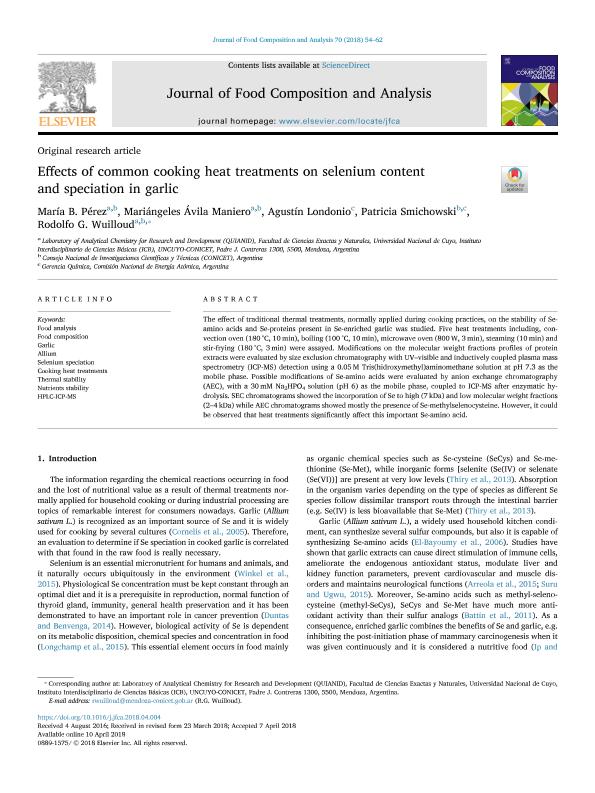Artículo
Effects of common cooking heat treatments on selenium content and speciation in garlic
Pérez, María Belén; Ávila Maniero, Mariángeles ; Londonio, Juan Agustín; Smichowski, Patricia Nora
; Londonio, Juan Agustín; Smichowski, Patricia Nora ; Wuilloud, Rodolfo German
; Wuilloud, Rodolfo German
 ; Londonio, Juan Agustín; Smichowski, Patricia Nora
; Londonio, Juan Agustín; Smichowski, Patricia Nora ; Wuilloud, Rodolfo German
; Wuilloud, Rodolfo German
Fecha de publicación:
07/2018
Editorial:
Academic Press Inc Elsevier Science
Revista:
Journal of Food Composition and Analysis
ISSN:
0889-1575
Idioma:
Inglés
Tipo de recurso:
Artículo publicado
Clasificación temática:
Resumen
The effect of traditional thermal treatments, normally applied during cooking practices, on the stability of Se-amino acids and Se-proteins present in Se-enriched garlic was studied. Five heat treatments including, convection oven (180 °C, 10 min), boiling (100 °C, 10 min), microwave oven (800 W, 3 min), steaming (10 min) and stir-frying (180 °C, 3 min) were assayed. Modifications on the molecular weight fractions profiles of protein extracts were evaluated by size exclusion chromatography with UV–visible and inductively coupled plasma mass spectrometry (ICP-MS) detection using a 0.05 M Tris(hidroxymethyl)aminomethane solution at pH 7.3 as the mobile phase. Possible modifications of Se-amino acids were evaluated by anion exchange chromatography (AEC), with a 30 mM Na2HPO4 solution (pH 6) as the mobile phase, coupled to ICP-MS after enzymatic hydrolysis. SEC chromatograms showed the incorporation of Se to high (7 kDa) and low molecular weight fractions (2–4 kDa) while AEC chromatograms showed mostly the presence of Se-methylselenocysteine. However, it could be observed that heat treatments significantly affect this important Se-amino acid.
Archivos asociados
Licencia
Identificadores
Colecciones
Articulos(CCT - MENDOZA)
Articulos de CTRO.CIENTIFICO TECNOL.CONICET - MENDOZA
Articulos de CTRO.CIENTIFICO TECNOL.CONICET - MENDOZA
Articulos(SEDE CENTRAL)
Articulos de SEDE CENTRAL
Articulos de SEDE CENTRAL
Citación
Pérez, María Belén; Ávila Maniero, Mariángeles; Londonio, Juan Agustín; Smichowski, Patricia Nora; Wuilloud, Rodolfo German; Effects of common cooking heat treatments on selenium content and speciation in garlic; Academic Press Inc Elsevier Science; Journal of Food Composition and Analysis; 70; 7-2018; 54-62
Compartir
Altmétricas



